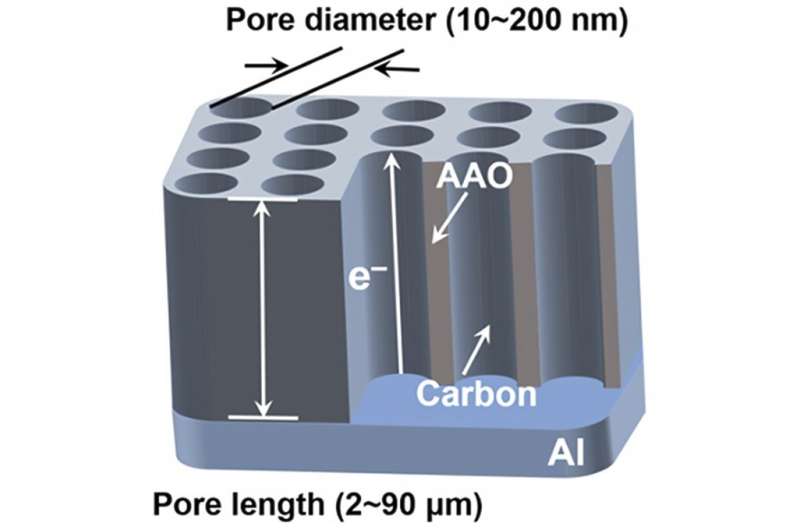This article has been reviewed according to Science X's editorial process and policies. Editors have highlighted the following attributes while ensuring the content's credibility:
fact-checked
peer-reviewed publication
trusted source
proofread
Unveiling the nanoscale frontier: Innovating with nanoporous model electrodes

Researchers at Tohoku University and Tsinghua University have introduced a next-generation model membrane electrode that promises to revolutionize fundamental electrochemical research. This innovative electrode, fabricated through a meticulous process, showcases an ordered array of hollow giant carbon nanotubes (gCNTs) within a nanoporous membrane, unlocking new possibilities for energy storage and electrochemical studies.
The key breakthrough lies in the construction of this novel electrode. The researchers developed a uniform carbon coating technique on anodic aluminum oxide (AAO) formed on an aluminum substrate, with the barrier layer eliminated. The resulting conformally carbon-coated layer exhibits vertically aligned gCNTs with nanopores ranging from 10 to 200 nm in diameter and 2 μm to 90 μm in length, covering small electrolyte molecules to bio-related large matters such as enzymes and exosomes.
Unlike traditional composite electrodes, this self-standing model electrode eliminates inter-particle contact, ensuring minimal contact resistance—something essential for interpreting the corresponding electrochemical behaviors.
"The potential of this model electrode is immense," stated Dr. Zheng-Ze Pan, one of the corresponding authors of the study, published in Advanced Functional Materials. "By employing the model membrane electrode with its extensive range of nanopore dimensions, we can attain profound insights into the intricate electrochemical processes transpiring within porous carbon electrodes, along with their inherent correlations to the nanopore dimensions."
Moreover, the gCNTs are composed of low-crystalline stacked graphene sheets, offering unparalleled access to the electrical conductivity within low-crystalline carbon walls. Through experimental measurements and the utilization of an in-house temperature-programmed desorption system, the researchers constructed an atomic-scale structural model of the low-crystalline carbon walls, enabling detailed theoretical simulations.
Dr. Alex Aziz, who carried out the simulation part for this research, points out, "Our advanced simulations provide a unique lens to estimate electron transitions within amorphous carbons, shedding light on the intricate mechanisms governing their electrical behavior."
More information: Hongyu Liu et al, Nanoporous Membrane Electrodes with an Ordered Array of Hollow Giant Carbon Nanotubes, Advanced Functional Materials (2023). DOI: 10.1002/adfm.202303730
Journal information: Advanced Functional Materials
Provided by Tohoku University




















